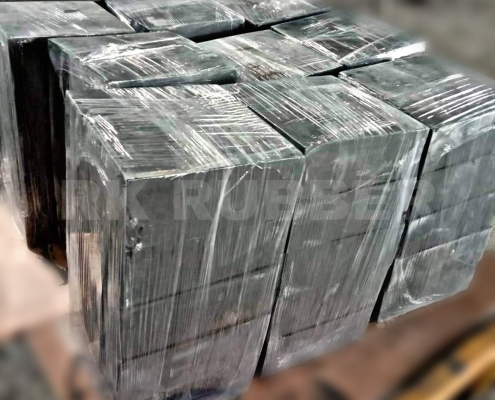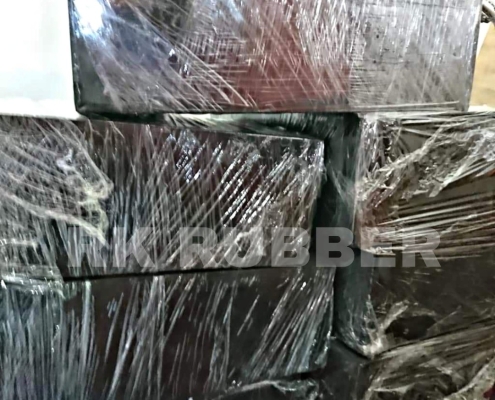Rubber Block
We manufacture different rubber block sizes for engineering, industrial, and shipping industries. The rubber block is usually made from SBR (Styrene-Butadiene Rubber), a compound rubber material with a polymer (elastic property) that makes it more durable and less rubbery than natural rubber. However, it’s cheaper than natural rubber without sacrificing its long-lasting wear and tear resistance. It is one of our rubber products with a wide range of applications, depending on its width and thickness.
Applications
Rubber blocks are commonly used in construction, automotive, and industrial applications. They are often used as a vibration dampener, noise reducer, or shock absorber. Some rubber blocks have adhesive on one side to stick to a surface. This can help create a seal or reinforce an object. Rubber blocks are cut from a sheet of rubber. The material is then compressed to form a block and can be machined, pressed, or molded. Rubber blocks are also known as resilient materials in the field of engineering.
Manufacturing Process
Rubber blocks are manufactured through several different processes. The two most common methods are compression molding and transfer molding. In compression molding, the rubber is heated until it is liquid and put into a mold. The pressure from the molding process causes the rubber to compress and harden. In transfer molding, the rubber is heated until it is liquid, then transferred to a mold. The pressure from the molding process causes the rubber to compress and harden.
Different Properties
Rubber blocks are a versatile material that has several desirable properties. They are strong and durable, making them ideal for building projects. They are also non-toxic and environmentally friendly, making them safe for children to play with. Additionally, rubber blocks are easy to clean and can be reused multiple times.
The type of rubber and the properties desired will determine the best block for the job. Hardness, resilience, and tear resistance are some of the most important properties when selecting a rubber block. Hardness refers to the resistance of rubber blocks to pressure. Rubber blocks that are too soft tend to wear down quickly, while those that are too hard can crack over time. Resilience measures a rubber block’s ability to return to its original shape after an impact.
Features of Rubber Block
- Solid and thick rubber – made from SBR (suitable replacement for natural rubber)
- Excellent resistance against wear and tear to increase its lifetime usage.
- Sturdy and durable, rated as 10/10 to handle huge machinery.
- Ideal protection for any huge machinery to reduce its vibration and noise levels – especially for soundproofing
- High resistance to impact – for safety purposes
- It has excellent weather resistance.
- It has a strong resistance to any corrosive, but it is not suitable to use along with hydrocarbons or oils.
- Its smooth surface and elasticity will not harm other components/machinery.
- It can be easily installed in your desired location.
- It has temperature resistance from -15°C up to 300 °C
Maintenance of Rubber Blocks
Maintenance for rubber blocks involves regular inspection, cleaning, and replacement as necessary to ensure optimal performance and longevity. To keep your rubber blocks in top condition, it is important to follow proper cleaning techniques. Start by removing any loose dirt or debris using a soft brush or cloth. For stubborn stains, a mild soap solution can be used along with gentle scrubbing. Avoid using harsh chemicals or abrasive cleaners as they can damage the rubber surface.
After cleaning, make sure to thoroughly dry the blocks before storing them in a cool and dry place. It is also advisable to store them away from direct sunlight to prevent UV damage. Additionally, practicing preventative maintenance such as avoiding extreme temperatures and excessive weight can help prolong the lifespan of your rubber blocks.
Frequently Asked Questions
How Long Do Rubber Blocks Typically Last?
The lifespan of rubber blocks typically depends on several factors such as the quality of the material, its exposure to external elements, and the level of maintenance provided. Rubber block maintenance tips can help prolong their durability, including regular cleaning, avoiding excessive weight or pressure, and protecting them from extreme temperatures or UV radiation. Benefits of using rubber blocks in construction include their shock absorption properties, noise reduction capabilities, and resistance to wear and tear. Different types of rubber blocks available cater to specific needs such as heavy-duty applications or specialized environments.
Are Rubber Blocks Recyclable?
Rubber blocks can be recycled, reducing their environmental impact. The recycling processes for rubber blocks involve shredding and grinding them into small pieces that can be used as raw material in the production of new rubber products. Alternatively, rubber blocks can also be repurposed for alternative uses such as playground surfaces or athletic tracks. Recycling rubber blocks not only diverts waste from landfills but also conserves natural resources by reducing the need for virgin rubber production.
Can Rubber Blocks Be Used in Outdoor Applications?
Durability in extreme weather conditions is a significant factor to consider when evaluating the suitability of rubber blocks for outdoor applications. Rubber blocks offer several benefits when used outdoors, including resistance to UV radiation, moisture, and temperature fluctuations. Additionally, rubber blocks require minimal maintenance in outdoor settings due to their inherent resilience and ability to withstand adverse environmental conditions. These characteristics make rubber blocks a practical choice for various outdoor applications where durability and low maintenance are desired.
Are Rubber Blocks Resistant to Chemical Exposure?
Chemical compatibility is an important aspect to consider when evaluating the potential use of rubber blocks. These blocks offer several benefits, such as their durability and resilience. They are commonly utilized in various applications, including industrial settings and construction projects. However, without proper chemical resistance, rubber blocks may be susceptible to degradation or damage when exposed to certain chemicals. Therefore, understanding the chemical compatibility of rubber blocks is crucial for ensuring their effectiveness and longevity in different environments.
Can Rubber Blocks Be Customized in Terms of Size and Shape?
Customization options for rubber blocks include the ability to alter their size and shape. This feature enables users to tailor the blocks to specific requirements, enhancing their versatility and adaptability in various applications. The advantages of using rubber blocks lie in their durability, resilience, and resistance to chemical exposure. These properties make them suitable for a wide range of uses in construction, such as vibration isolation, impact absorption, and load-bearing support.
Conclusion
In conclusion, rubber blocks have a rich history and offer a range of properties and characteristics that make them versatile in various applications. Their ability to absorb impact, resist abrasion, and provide excellent grip makes them ideal for use in industries such as automotive, construction, and manufacturing. Despite their advantages, it is important to consider the disadvantages of rubber blocks such as their susceptibility to degradation over time.
Choosing the right rubber block requires careful consideration of factors such as hardness, temperature resistance, and chemical compatibility. Regular maintenance is crucial to prolonging the lifespan of rubber blocks and ensuring optimal performance. So next time you encounter a rubber block, remember its resilience and adaptability that have made it an indispensable component in countless industries around the world.
Below are some of the actual products and applications.










